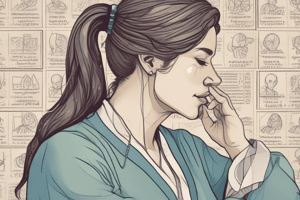Podcast
Questions and Answers
What percentage of headaches are classified as primary headaches?
What percentage of headaches are classified as primary headaches?
- 90% (correct)
- 80%
- 95%
- 50%
What is a possible cause of secondary headaches?
What is a possible cause of secondary headaches?
- Stress
- Depression
- Head trauma (correct)
- Exercise
Which type of headache is more severe and debilitating?
Which type of headache is more severe and debilitating?
- Tension headache
- Migraine headache (correct)
- Cluster headache
- Chronic headache
What characteristic of pain is often exacerbated by pressure or stress?
What characteristic of pain is often exacerbated by pressure or stress?
What is a characteristic of chronic tension-type headaches?
What is a characteristic of chronic tension-type headaches?
Approximately what percentage of patients with migraine have family histories of migraine?
Approximately what percentage of patients with migraine have family histories of migraine?
What may increase the pain of a tension-type headache?
What may increase the pain of a tension-type headache?
What is a possible associated condition of chronic tension-type headaches?
What is a possible associated condition of chronic tension-type headaches?
Which of the following is NOT a trigger for migraine?
Which of the following is NOT a trigger for migraine?
How would a patient with a tension-type headache describe the pain?
How would a patient with a tension-type headache describe the pain?
What type of migraine occurs almost twice as frequently as migraine without aura?
What type of migraine occurs almost twice as frequently as migraine without aura?
Which of the following foods is a trigger for migraine?
Which of the following foods is a trigger for migraine?
What is a characteristic of the pain of a tension-type headache?
What is a characteristic of the pain of a tension-type headache?
During which stage of the ovarian cycle do menstrual migraines occur?
During which stage of the ovarian cycle do menstrual migraines occur?
Flashcards are hidden until you start studying
Study Notes
Headache
- Headache is a symptom of pain anywhere in the head or neck region, not a disease state.
- Two-thirds of non-prescription analgesic use may be for headache.
Types of Headaches
- Primary headaches (~90% of headaches) are not associated with an underlying illness.
- Examples of primary headaches include:
- Episodic and chronic tension-type headaches
- Migraine headaches with and without aura
- Cluster headaches
Primary Headaches
Tension-type Headaches
- Also known as stress headaches, often appear in response to stress, anxiety, depression, and emotional conflicts.
- Can be either episodic or chronic.
- Chronic headaches occur 15 or more days per month for at least 3 months.
- The most common type of primary headache.
- Clinical Presentation:
- Severity of pain is highly variable.
- Shivering or cold temperatures may increase pain.
- Associated with sleep disturbances, shortness of breath, constipation, weight loss, fatigue, decreased sexual drive, palpitations, and menstrual changes.
- Pain is described as tightness or a weight pressing down on the head.
- Pain is gradual in onset and tends to worsen progressively throughout the day.
- Pain is normally mild to moderate and not aggravated by movement.
Migraine
- The second most common type of primary headache.
- Recurrent, often life-long, and characterized by recurring attacks.
- Migraine with aura (neurologic symptoms that precede the head pain) occurs almost twice as frequently as migraine without aura.
- Up to 70% of patients with migraine have family histories of migraine, suggesting a hereditary influence.
- Triggers:
- Stress, fatigue, and irregular sleep patterns.
- Fasting or a missed meal, vasoactive substances in food, caffeine, alcohol, cheeses, salty foods, chocolate, and citrus fruits.
- Changes in female hormones.
- Changes in barometric pressure and altitude.
- Lights, odor, neck pain, and exercise.
- Medications (e.g., reserpine, nitrates, oral contraceptives, and postmenopausal hormones).
- Menstrual migraines appear at the menstrual stage of the ovarian cycle and occur in approximately 60% of women with migraine.
Studying That Suits You
Use AI to generate personalized quizzes and flashcards to suit your learning preferences.




